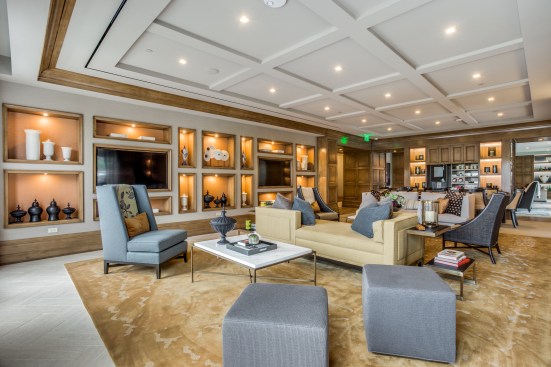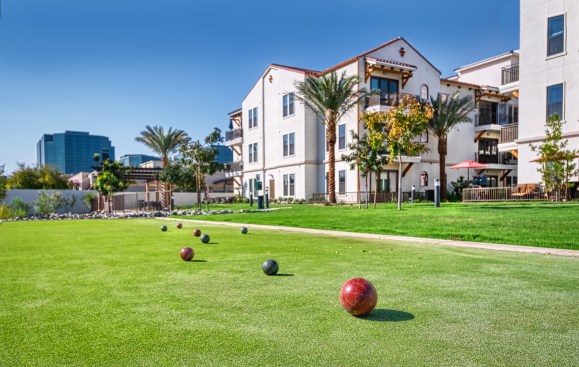To appeal to the growing cohort of baby boomer renters who are downsizing to apartments right now, you’ve got to think big, go long on meaningful amenities, and cut through the clutter by simplifying your in-home tech.
That’s the consensus from developers and designers focused on this lucrative and expanding segment of the apartment market.
“Boomers hold the bulk of the wealth in this country and will pay a higher price per square foot on rent,” notes Brooklyn-based multifamily architect Eugene Colberg. “They want to be integrated into the larger community and have accessibility to ancillary services.”
Call it the apartment universe’s theory of relativity: As boomers downsize from single-family homes and choose a hassle-free lifestyle that’s untethered from the obligations of ownership, one of the counterintuitive aspects of creating apartments they want comes down to making them bigger but simpler, while devoting common area space to activities and extras that engage.

Courtesy StreetLights Residential
Take Allaso Vineyards, a high-end community in Albuquerque, New Mexico. Titan Development, which operates 1,722 units throughout the Southwest, pumped up the volume of the apartment homes there in the spaces that matter most to this demographic.
“Boomers are interested in extra closet and storage space, so we increased the unit sizes within this community by 10% more than a typical multifamily project in today’s market,” says Joshua Rogers, Titan’s vice president of development. “This not only gave residents the storage space boomers covet, it also allowed us to add a dining room in the apartment itself. That’s not a common feature in multifamily projects anymore, because millennials don’t like them. But for boomers, it’s a necessary feature.”
Indeed, multifamily pros say design trends for these communities have taken a U-turn away from over-the-top, tech-focused amenities favored in millennial-focused communities to embrace a simplified lifestyle instead.
“From a designer’s perspective, when creating apartments for boomers, you’re literally going back in time about 10 years,” Rogers says. “It’s really a minimalist approach.” For example, instead of the streaming-everything approach that appeals to millennials, boomers still prefer to have wired entertainment options. “They still want traditional cable,” Rogers says. “They’re more interested in an apartment that offers conveniently located coaxial outlets, rather than Wi-Fi connectivity.”
At Atlanta-based Cortland, which operates 65,000 units, executive vice president of design and architecture Darla Dillon says outside the apartment homes, older residents are more interested in amenities that engage them with each other, rather than ones that allow millennials to be “alone together.”

Courtesy Cortland
“Senior and boomer renters’ interests lie elsewhere,” Dillon says. “On-site games such as bocce ball, shuffleboard, and pickleball have appeal.”
Active amenities also appeal to this group’s desire to stay young.
“From a psychographic point of view, these residents do not want to be defined as ‘elderly’ or even ‘older,’” says Anthony Vivirito, senior project manager at Chelsea, Massachusetts-based design firm The Architectural Team. “We’re seeing interest in active amenities that wouldn’t fit for a property targeting millennials—think wood shops and other maker spaces, golf simulators, bike rooms and storage, dedicated wellness areas, outdoor gathering spaces with game courts.”
For these residents, Cortland’s Dillon says, simplicity and convenience are key, as well as community mechanicals that help them move easily throughout the property.
“Developers should consider numerous elevators, minimal stairs, neutral palettes, and centrally located mail centers,” Dillon says. “Interior and exterior trash chutes that are universally accessible, such as integrated trash cans, enable residents to dispose of garbage without leaving their units. We cater to seniors’ and boomers’ needs by designing larger floor plans, installing quality lighting, and building spacious kitchens with ample storage space.”
That emphasis on storage is key. Even though boomers may have sold or disposed of the bulk of their possessions when they downsized, you still need to provide plenty of storage, both inside and outside units, to help these residents deal with a lifetime of stuff.
“Inside the units, adjustable shelves and flexible closet systems are a must, while additional on-site, rentable storage units are also popular,” says Geoffrey Woodrum, vice president of design at Dallas-based StreetLights Residential, which operates 11,386 units across six states. “Close storage keeps residents from walking across the property to access their belongings.”
In space-constrained New York City, clever storage options are even more important. “We always advise our buildings to have temperature-controlled storage available on site,” says Whitney Kraus, chief architecture and design officer for Brown Harris Stevens Development Marketing. “We push hard for design teams to use every square inch smartly—like medicine cabinets above the sink, in addition to a full-height storage cabinets in the bathroom.”
But simplifying things for boomers doesn’t mean you can skimp on finishes. “Boomer renters are typically moving from homes they have lived in a long time,” says Jennifer Rosenberg, development director at Philadelphia-based Keystone Property Group. “They are used to higher-end finishes and larger spaces. When they move to apartments they tend to expect the same thing on a smaller scale.”
She ticks off the must-have elements of a boomer-focused community: 24/7 concierge and security; a fitness center in the building; hardwood floors throughout units; in-unit washer and dryer; and storage on site. Extras that also appeal include windows that open, private balconies and terraces, a conference room, and a lounge in the amenity center.
By providing larger apartments with plenty of space for storage and simplifying tech and entertainment options, while giving boomer residents the activities and outlets they want to connect with each other, multifamily pros can tap into this surging apartment demographic.

